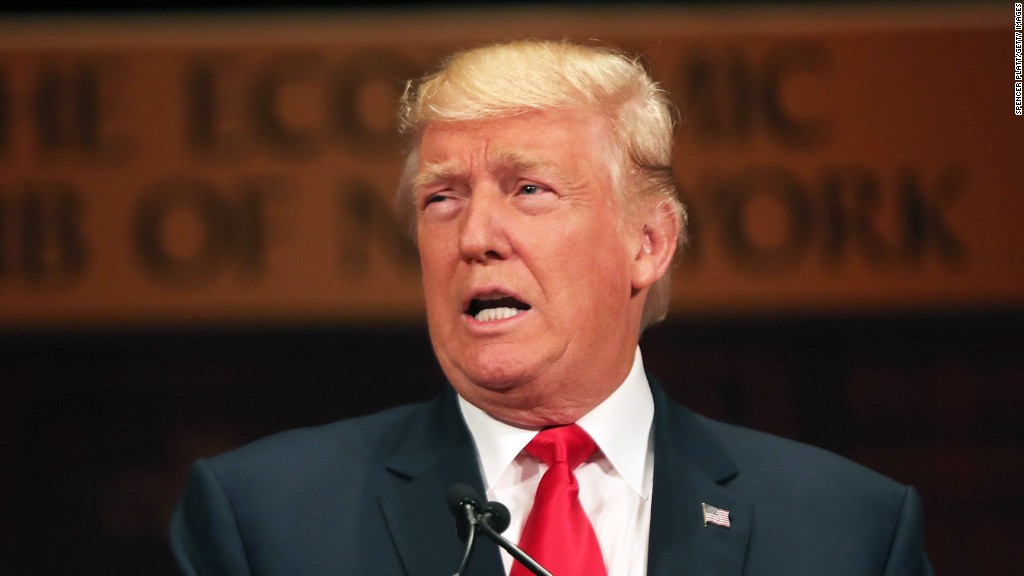
No matter how you measure it, the latest version of Donald Trump's tax plan will still cost a lot, although it's considerably less than his original proposal.
The revised plan will still give everyone a tax cut and it will still benefit the rich more than anyone else. But in both cases it would be to a lesser degree. It would also offer substantial tax cuts to corporations.
The Tax Foundation put out a report Monday morning estimating that Trump's revised plan will cost anywhere between $2.6 trillion and $5.9 trillion. That's still expensive, but it's much less than the more than $10 trillion his original plan was estimated to cost.
So, why the wide range of estimates? Normally the Tax Foundation would score the plan only twice -- once based on the tax changes themselves, and then again taking into account the potential effects of the changes on jobs, wages, investments and economic growth.
But this time the group, which advocates for lower taxes, had to score the plan four different ways thanks to confusion caused by the Trump campaign's refusal to clarify his plan for business taxes. It's still unclear whether the plan would apply a flat 15% rate just to corporate income or to all business income, as Trump had proposed last year.
Related: Trump makes major changes to his tax plan
In both cases, it would be a huge tax cut.
But giving every small business and lucrative partnership that 15% rate would cost considerably more than just limiting it to corporations -- over $1 trillion more, according to the Tax Foundation's calculations. And one of the reasons Trump revised his tax plan in the first place was to reduce its overall cost.
So, assuming no economic effects, the Tax Foundation estimates the plan would cost between $4.4 trillion and $5.9 trillion, with the latter reflecting a scenario in which all business income is taxed at 15%. Taking into account the macroeconomic effects, the estimated cost ranges from $2.6 trillion to $3.9 trillion.
The Trump campaign has yet to respond to requests for clarity on the issue. It did, however, change the wording on the tax plan since it was released last Thursday to now indicate "the Trump plan will lower the business tax rate from 35 percent to 15 percent, available to all businesses, both big and small, that want to retain the profits within the business."
But even that change raises questions. Since 35% is the top rate for corporations only, does that mean that all businesses that want the new 15% rate will have to restructure as corporations?
How would the economy be effected?
Thanks largely to the lower cost on capital under Trump's plan, the Tax Foundation estimates that the plan could grow the economy by another 7% to 8% cumulatively over the course of a decade relative to what's assumed under current policy. It also estimates that wages could grow by an additional 5% to 6%, and result in 1.8 million to 2.2 million more jobs.
But there are important caveats to those estimates: The Tax Foundation analysis does not account for the economic effects of Trump's other, non-tax-related policies, such as trade and immigration. Nor does it account for the economic effects of any spending cuts or other measures that might be implemented to cure the deficit caused by Trump's tax plan.
It also doesn't factor in the effects of doing nothing to cure that projected drop in federal revenue.
How much would Americans' taxes be cut?
Broadly speaking, the Tax Foundation estimates everyone would see lower taxes under Trump's latest plan.
Under the scenario that excludes macroeconomic effects, those in the middle of the income distribution would see their tax bills cut by 1.3% on average, while those at the very top would see a drop of 10.2%. Those at the bottom would see a 1.2% decline, although since they typically don't end up owing federal income taxes, that could mean a 1.2% bump in their refunds.
The percentages go up a lot once macroeconomic effects are considered. The middle, for instance, would see a drop in their tax bills of between 7.7% and 9%; and for the top between 12% and 20%.


